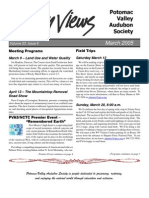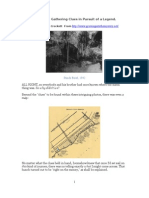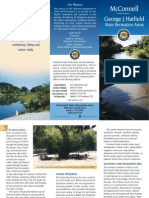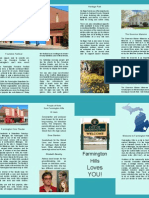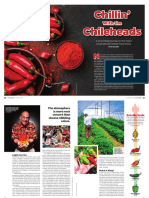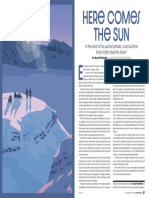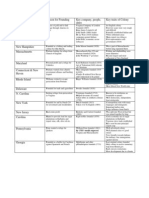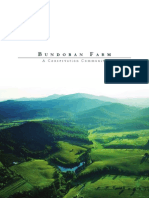Virginia's Origin Story
Virginia's Origin Story
Uploaded by
Meghan O'DellCopyright:
Available Formats
Virginia's Origin Story
Virginia's Origin Story
Uploaded by
Meghan O'DellOriginal Description:
Copyright
Available Formats
Share this document
Did you find this document useful?
Is this content inappropriate?
Copyright:
Available Formats
Virginia's Origin Story
Virginia's Origin Story
Uploaded by
Meghan O'DellCopyright:
Available Formats
virginia’s
originstory Learn about Native American heritage
on a visit to our newest state park
BY LARRY BLEIBERG
A
s I drive across the towering George meeting Machicomoco
P. Coleman Memorial Bridge to I’m road-tripping to Machicomoco State Park,
Gloucester Point, the York River looks Virginia’s newest state park. An Algonquin tribal word,
intimidating, a powerful waterway Machicomoco means “special meeting place.” The
pouring into the mouth of the Chesapeake Bay. riverfront property provides something visitors can’t
What would it have been like 400 years ago, find elsewhere: the most complete look at Virginia’s
I wonder, when Pocahontas or her father, Chief story through the eyes of its original inhabitants.
Powhatan, paddled these deep tidal waters in a “Never in its existence has the commonwealth
dugout canoe? designated a site so replete with rich native histo-
This river was certainly familiar to the famous ry as Machicomoco,” said Stephen R. Adkins, chief
daughter and father. They lived upstream and of the Chickahominy tribe, at the park’s opening
would undoubtedly have explored the shoreline, ceremony last spring. “This offers just a unique, un-
likely visiting my destination today: a tiny peninsu- precedented opportunity to tell those stories that
la not far from the bridge. have been held hostage so long.”
The small American Indian community who re- Indeed, I don’t remember learning much about
sided there grew corn, beans, and squash, and har- the state’s original Native Americans from my
vested oysters from the waters that surrounded fourth-grade Virginia history class. I’m happy the
their home. Archaeological evidence suggests peo- park is giving me another chance.
ple had been inhabiting the area for 10,000 years. The 645-acre preserve was developed in consul-
Today, the land is once again a center for Native tation with the 11 Native American tribes recognized
American life. by the state of Virginia: the Chickahominy, Eastern
COURTESY VIRGINIA STATE PARKS/BETTY SAXMAN
The park’s open-
air steel and wood
interpretive pavillion
was inspired by
traditional Native
American buildings.
AAA.COM APRIL/MAY/JUNE 2022 AAA EXPLORER | 35
Clockwise from Chickahominy, Mattaponi, Upper Mattaponi, and eventually donated it to the state in 2017 to
left: Algonquin make the park.
Monacan, Nansemond, Nottoway, Cheroenhaka
words are
etched into (Nottoway), Pamunkey, Patawomeck, and The area remains a sanctuary of woods, farm
steps; Chief Rappahannock. The grounds were designed by fields, creeks, and low-lying islands that might
Walter D. Charlottesville-based Nelson Byrd Woltz Landscape have been recognizable to Pocahontas and
“Red Hawk” her peers.
Architects, which has worked on award-winning
Brown III of the
Cheroenhaka park and cultural projects around the world.
Nottoway Indian Shaleigh R. Howells, cultural resource direc- Tidewater Timeline
Tribe, at the tor and museum director of the Pamunkey Indian While the park offers typical amenities, including
Machicomoco a campground, boat launch, and small gift shop,
Museum and Cultural Center, said Virginia’s other
State Park’s
dedication; parks might typically have a marker mentioning in- it’s the interpretive area that draws me in on this
a map shows digenous people. At the new park, the story goes sunny day. I drive about a mile from the entrance
the reach of much deeper. and stop in a parking area near a rise overlook-
CLOCKWISE FROM TOP LEFT: LARRY BLEIBERG; COURTESY VIRGINIA STATE PARKS (2)
the Powhatan “It’s very different, it’s not 1 or 2 signs,” said ing a tidal inlet. In front of me, a timeline of en-
Confederacy.
Howells. “It’s solely based around the stories of graved stones covering 20,000 years of history
Native Americans and how they want to tell their runs across the ground for hundreds of feet.
stories and history.” The story of Machicomoco, I learn, begins in
Finding Machicomoco, though, proves a little 18,000 BC during the last Ice Age, which creat-
tricky. I turn off busy US 17 and follow a county ed the Tidewater river systems that shaped Native
road by farms and rural homes. Just as I begin to American life here.
wonder if I’m lost, nearing what feels like a gated Walking the timeline, I see the American Indian
community, I pull up to what I hope is the park’s story unfold. Thousands of years later, hunter-
entrance booth. (Spoiler alert: It was.) gatherers began to appear in coastal Virginia,
As I learn, we are lucky even to have a park. eventually forming large settlements in the
More than a decade ago, the land was sold to Chesapeake floodplains. Then came contact with
developers, who built the entrance building, a Europeans, beginning with Spanish missionaries
floating dock, and a 3-mile ring road for a lux- in 1570, leading to wars with the British, forcible
ury subdivision. But the developer faced finan- removal from land, and, finally, centuries later, the
cial challenges, and before ground was broken on park’s dedication.
homes, a private foundation purchased the land Along the way, I pass native plants like sage,
36 | AAA EXPLORER APRIL/MAY/JUNE 2022 AAA.COM
Land of 5 seasons
The new park features 3 rental yurts and 5 miles
of paths. Its handicap-accessible launch offers
kayakers access to creeks and the York River,
which American Indians called the Pamunkey. But
throughout Machicomoco are places to learn
about the land’s original inhabitants.
Strolling through the park, I find Algonquin
words etched into boardwalks and steps. The
culture begins to come alive through words like
pissacoack, which means, “muddy place,” or mat-
tapanient, which translates as “stopping place on
a path.”
The park honey locust, and bluestem grass, and reach a In another area, a panel describes the indige-
overlooks tidal shelter, inspired by the longhouses favored by nous Virginian’s 5 seasons. Why, I suddenly wonder,
creeks and inlets
Virginia’s American Indians. did I assume there had to be 4?
that lead to the
York River. The traditional buildings were constructed from For the Native Americans, living in the coast-
saplings bent into hoops and then covered with al plain meant an early spring period for planting
bark and woven mats. Machicomoco’s modern and fish runs; summer for foraging wild plants; late
version is made from steel and black locust timbers summer and early fall for harvesting; late fall for
topped by metal panels. feasts and ceremonies; and winter for forest hunts.
The park’s location is significant because it was Earlier, I had asked Howells, the Pamunkey mu-
the gateway to Werowocomoco, the Powhattan seum director, how best to experience the park.
Confederacy’s capital and ceremonial center, Take time to absorb it, she told me. Reflect on its
which was located about 10 miles upstream. complex history and admire the waterfront land-
(Considered sacred by Native Americans, the for- scape, home to deer, foxes, turkeys, and, as I saw,
mer capital is now owned by the National Park an eagle’s nest with a commanding river view.
Service and closed to the public as it undergoes “It is culturally significant land for Native
extensive archaeological research.) Americans,” she said. But there’s more to it. “It’s
That makes Machicomoco the best spot to also really pretty.”
learn about the Powhatan Confederacy. The group, Looking out to the inlets, where pods of bot-
which included 15,000 people from 30 tribes, be- tlenose dolphins often congregate and the sun
Read about gan to form in the 1200s, and grew at its peak gleams off the shifting water, I can’t disagree. And
things to to cover 16,000 square miles, stretching from for all that has changed in the last 400 years, I have
do around Washington, D.C., to the North Carolina border. to believe that Powhatan and Pocahontas must
Machicomoco in Prime real estate, then and now. have enjoyed the view too.
the digital-extra Werowocomoco is also where Captain John
version of this Smith, the founder of Jamestown, was taken af-
article at ter his capture. During his time there, Powhatan, Freelance writer LARRY BLEIBERG lives in
aaa.com known as the “chief of chiefs,” offered to sell him Charlottesville, Virginia—land once home to the
/explorer. the land that’s now Machicomoco park. Monacan Indian Nation.
More Native sites in Virginia
Take a 50-mile drive northwest of Machicomoco to visit the Head to the mountains to learn about tribal traditions at the
Pamunkey Indian Museum and Cultural Center. The Monacan Ancestral Museum. Near Lynchburg, the museum honors
Pamunkey Indians were part of the Powhatan Confederacy, the Sioux-speaking Monacan, who once controlled much of Virginia’s
and this decades-old institution was the first opened by a Piedmont area and were rivals of the Powhatan Confederacy. The
Virginia tribe. Located on its 1,200-acre reservation, exhibits museum features an 1870 log cabin schoolhouse and a century-old
LARRY BLEIBERG
at the museum include a dugout canoe, ancient stone mission church. Exhibits include pottery, baskets, beadwork, and
points, and a treaty signed with the English in 1677. Open by photographs. Open Tuesday to Saturday. Call for appointment.
appointment. (804) 843-4792; pamunkey.org. (434) 946-5391; monacannation.com/ancestral-museum.html.
38 | AAA EXPLORER APRIL/MAY/JUNE 2022 AAA.COM
You might also like
- An Evening in Guanima: A Treasury of Folktales from The BahamasFrom EverandAn Evening in Guanima: A Treasury of Folktales from The BahamasRating: 4.5 out of 5 stars4.5/5 (4)
- Westways GreatGetawaysDocument7 pagesWestways GreatGetawaysMeghan O'DellNo ratings yet
- Waipi’O Valley: A Polynesian Journey from Eden to Eden Volume 1From EverandWaipi’O Valley: A Polynesian Journey from Eden to Eden Volume 1No ratings yet
- Segmentation at Sticks Kebob ShopDocument10 pagesSegmentation at Sticks Kebob ShopABHISHEK SINGHNo ratings yet
- Santa Cruz Mission State Historic Park BrochureDocument4 pagesSanta Cruz Mission State Historic Park BrochureCalifornia State ParksNo ratings yet
- Spirits of the Coast: Orcas in Science, Art and HistoryFrom EverandSpirits of the Coast: Orcas in Science, Art and HistoryNo ratings yet
- The World of the Salt Marsh: Appreciating and Protecting the Tidal Marshes of the Southeastern Atlantic CoastFrom EverandThe World of the Salt Marsh: Appreciating and Protecting the Tidal Marshes of the Southeastern Atlantic CoastNo ratings yet
- The Philips Family of Nashville TennesseeDocument365 pagesThe Philips Family of Nashville TennesseeLarry Feldhaus100% (1)
- Belize by JimnyDocument5 pagesBelize by JimnyCaribbean Travel + LifeNo ratings yet
- One Man's Extraordinary Quest To Find "The Devil's Punch Bowl," or Maybe A Piece of His Heart. Chapter 1Document6 pagesOne Man's Extraordinary Quest To Find "The Devil's Punch Bowl," or Maybe A Piece of His Heart. Chapter 1P_CrockettNo ratings yet
- March 2005: Potomac Valley Audubon SocietyDocument6 pagesMarch 2005: Potomac Valley Audubon SocietyPotomac Valley Audubon SocietyNo ratings yet
- Chapter 2: Gathering Clues in Pursuit of A Legend.Document13 pagesChapter 2: Gathering Clues in Pursuit of A Legend.P_CrockettNo ratings yet
- Pigeon Point Light Station State Historic Park BrochureDocument4 pagesPigeon Point Light Station State Historic Park BrochureCalifornia State ParksNo ratings yet
- Tales from The Children of The Sea, Volume 1, The Last Wooden HouseFrom EverandTales from The Children of The Sea, Volume 1, The Last Wooden HouseNo ratings yet
- National American Indian Heritage MonthDocument10 pagesNational American Indian Heritage MonthRayanne MorrisNo ratings yet
- McConnell State Recreaion Area Park BrochureDocument8 pagesMcConnell State Recreaion Area Park BrochureCalifornia State ParksNo ratings yet
- Arizona National Parks and Monuments: Scenic Wonders and Cultural Treasures of the Grand Canyon StateFrom EverandArizona National Parks and Monuments: Scenic Wonders and Cultural Treasures of the Grand Canyon StateNo ratings yet
- Visitor Guide: Également Offert en FrançaisDocument16 pagesVisitor Guide: Également Offert en FrançaisBarlot Tout-courtNo ratings yet
- 20728Document21 pages20728lauttmeratwgNo ratings yet
- (1885) Se-Quo-Yah: The American Cadmus and Modern Moses: A Complete Biography of The Greatest of RedmenDocument288 pages(1885) Se-Quo-Yah: The American Cadmus and Modern Moses: A Complete Biography of The Greatest of RedmenHerbert Hillary Booker 2nd100% (1)
- The Manunggul Jar As A Vessel of History PDFDocument7 pagesThe Manunggul Jar As A Vessel of History PDFRQL83appNo ratings yet
- Fifth EssenceDocument72 pagesFifth EssencebabuNo ratings yet
- Texturized Hoodoos. A Photoalbum From Bryce Canyon National ParkDocument53 pagesTexturized Hoodoos. A Photoalbum From Bryce Canyon National ParkFlorentin SmarandacheNo ratings yet
- People of the Water- A novella of the events leading to the Bloody Island Massacre of 1850From EverandPeople of the Water- A novella of the events leading to the Bloody Island Massacre of 1850No ratings yet
- Gagnon2018 - Mapping Memories in A Flooded LandscapeDocument13 pagesGagnon2018 - Mapping Memories in A Flooded LandscapeGonzalo BORQUEZ DIAZNo ratings yet
- Revised Hometown BrochureDocument2 pagesRevised Hometown BrochurekenseyNo ratings yet
- Desert Magazine 1952 JanuaryDocument44 pagesDesert Magazine 1952 Januarydm1937No ratings yet
- East Coast USA and Canada End New YorkDocument9 pagesEast Coast USA and Canada End New Yorkcatherine.castroNo ratings yet
- (Ebooks PDF) Download Made From Bone Trickster Myths Music and History From The Amazon 1st Edition Jonathan D. Hill Full ChaptersDocument60 pages(Ebooks PDF) Download Made From Bone Trickster Myths Music and History From The Amazon 1st Edition Jonathan D. Hill Full Chapterssapekakula100% (13)
- Asilomar State Beach Park BrochureDocument4 pagesAsilomar State Beach Park BrochureCalifornia State ParksNo ratings yet
- Hearst San Simeon State Park BrochureDocument7 pagesHearst San Simeon State Park BrochureCalifornia State ParksNo ratings yet
- SEN-B1 Preserving Memories - ReadingDocument3 pagesSEN-B1 Preserving Memories - ReadingDanielNo ratings yet
- Horseshoe CanyonDocument2 pagesHorseshoe Canyonlubas2No ratings yet
- (1913) The Land of The New Guinea PygmiesDocument454 pages(1913) The Land of The New Guinea PygmiesHerbert Hillary Booker 2ndNo ratings yet
- (1896) in The Heart of Cape Ann: or The Story of Dogtown (Volume 1)Document84 pages(1896) in The Heart of Cape Ann: or The Story of Dogtown (Volume 1)Herbert Hillary Booker 2ndNo ratings yet
- ClearLakeWebBrochure2012Document4 pagesClearLakeWebBrochure2012Hugh HendersonNo ratings yet
- The Reservoir PDFDocument8 pagesThe Reservoir PDFsgaspari687No ratings yet
- DTP Tour Map Brochure 2017-3Document4 pagesDTP Tour Map Brochure 2017-3mamey-limeNo ratings yet
- The Basket, Or, The Journal of The Basket FraternityDocument333 pagesThe Basket, Or, The Journal of The Basket FraternityabcdsefNo ratings yet
- Touch History: Save The Date: July 16, 2011Document4 pagesTouch History: Save The Date: July 16, 2011SculptureParkPCNo ratings yet
- Jamestown Colonial Settlements in America 1st Edition Tim Mcneese all chapter instant downloadDocument81 pagesJamestown Colonial Settlements in America 1st Edition Tim Mcneese all chapter instant downloadbijemwsoplan26100% (5)
- West Vacation PlannerDocument20 pagesWest Vacation Plannerlaikinha01No ratings yet
- Chino Hills State Park BrochureDocument5 pagesChino Hills State Park BrochureCalifornia State ParksNo ratings yet
- AAAExplorer BirdingDocument4 pagesAAAExplorer BirdingMeghan O'DellNo ratings yet
- AAAExplorer KentuckyDerbyDocument3 pagesAAAExplorer KentuckyDerbyMeghan O'DellNo ratings yet
- AAAExplorer EarthshipsDocument3 pagesAAAExplorer EarthshipsMeghan O'DellNo ratings yet
- Westways ParisDocument3 pagesWestways ParisMeghan O'DellNo ratings yet
- AAAExplorer FieryFoodsDocument3 pagesAAAExplorer FieryFoodsMeghan O'DellNo ratings yet
- Westways ColoradoSpringsDocument2 pagesWestways ColoradoSpringsMeghan O'DellNo ratings yet
- AAAExplorer PrinceEdwardIslandDocument3 pagesAAAExplorer PrinceEdwardIslandMeghan O'DellNo ratings yet
- AAAExplorer ScenicTrainInVirginiaDocument3 pagesAAAExplorer ScenicTrainInVirginiaMeghan O'DellNo ratings yet
- Westways HollywoodDocument2 pagesWestways HollywoodMeghan O'DellNo ratings yet
- AAAExplorer WaiKaiSurfParkDocument3 pagesAAAExplorer WaiKaiSurfParkMeghan O'DellNo ratings yet
- Westways BogotaDocument3 pagesWestways BogotaMeghan O'DellNo ratings yet
- AAAExplorer SvalbardEssayDocument1 pageAAAExplorer SvalbardEssayMeghan O'DellNo ratings yet
- AAAExplorer IsleOfWonderDocument3 pagesAAAExplorer IsleOfWonderMeghan O'DellNo ratings yet
- AAAExplorer FoodTrucksDocument3 pagesAAAExplorer FoodTrucksMeghan O'DellNo ratings yet
- AAAExplorer BluesBuffetDocument3 pagesAAAExplorer BluesBuffetMeghan O'DellNo ratings yet
- AAAExplorer ShumlaDocument3 pagesAAAExplorer ShumlaMeghan O'DellNo ratings yet
- AAAExplorer RomeCarbonaraDocument3 pagesAAAExplorer RomeCarbonaraMeghan O'DellNo ratings yet
- Road FoodDocument2 pagesRoad FoodMeghan O'DellNo ratings yet
- The Year of The CruiseDocument8 pagesThe Year of The CruiseMeghan O'DellNo ratings yet
- AAAExplorer KeeperOfTheStoriesDocument1 pageAAAExplorer KeeperOfTheStoriesMeghan O'DellNo ratings yet
- AAAExplorer AmazingRaceDocument3 pagesAAAExplorer AmazingRaceMeghan O'DellNo ratings yet
- AAAExplorer AlabamaBBQDocument3 pagesAAAExplorer AlabamaBBQMeghan O'DellNo ratings yet
- A Tale of Two CitiesDocument3 pagesA Tale of Two CitiesMeghan O'DellNo ratings yet
- Living HistoryDocument3 pagesLiving HistoryMeghan O'DellNo ratings yet
- The Ripple EffectDocument1 pageThe Ripple EffectMeghan O'DellNo ratings yet
- Game TimeDocument3 pagesGame TimeMeghan O'DellNo ratings yet
- Seoul FoodDocument3 pagesSeoul FoodMeghan O'DellNo ratings yet
- 2022 Photo Contest WinnersDocument5 pages2022 Photo Contest WinnersMeghan O'DellNo ratings yet
- The Art of Opening UpDocument1 pageThe Art of Opening UpMeghan O'DellNo ratings yet
- Charlottesville RestaurantsDocument15 pagesCharlottesville Restaurantsjmilton100% (2)
- African Americans at JamestownDocument262 pagesAfrican Americans at Jamestownshawanda_davis100% (3)
- (Ebooks PDF) Download Thomas Jefferson S Education First Edition Alan Taylor Full ChaptersDocument52 pages(Ebooks PDF) Download Thomas Jefferson S Education First Edition Alan Taylor Full Chaptersnadryalmalt100% (2)
- Robert Gentil Blogspot .Document7 pagesRobert Gentil Blogspot .Robert GentilNo ratings yet
- 13 Colonies ChartDocument1 page13 Colonies ChartAlex KaauaNo ratings yet
- Daniel Greenberg ResumeDocument1 pageDaniel Greenberg ResumeDan GreenbergNo ratings yet
- Teaching Resume - RushtonDocument2 pagesTeaching Resume - Rushtonapi-385665199No ratings yet
- Virginia State Tourism Plan VTC 3292013Document184 pagesVirginia State Tourism Plan VTC 3292013Raajeswaran BaskaranNo ratings yet
- 2020 VAPB Finalists - ListDocument7 pages2020 VAPB Finalists - ListPat ThomasNo ratings yet
- 2020 Common Agenda - 9.23Document130 pages2020 Common Agenda - 9.23Lowell FeldNo ratings yet
- Manu UsaDocument3 pagesManu UsaAnonymous a5KRimY5No ratings yet
- Media Coordinator or Spokesperson or Reporter or Journalist or MDocument2 pagesMedia Coordinator or Spokesperson or Reporter or Journalist or Mapi-79013799No ratings yet
- Cypress Landing Housing For VeteransDocument24 pagesCypress Landing Housing For VeteransEmmanuel BrayNo ratings yet
- Nema WC 3Document144 pagesNema WC 3comamierda100% (1)
- Mabe Baylee Resume 2013 Nov 11 EportfolioDocument2 pagesMabe Baylee Resume 2013 Nov 11 Eportfolioapi-219878313No ratings yet
- VirginiaMap Cities-CountiesDocument1 pageVirginiaMap Cities-CountiesTomasNo ratings yet
- Urgent Concern - Constitutional Violations in Virginia (11.8.2021)Document1 pageUrgent Concern - Constitutional Violations in Virginia (11.8.2021)Activate VirginiaNo ratings yet
- Bundoran FarmDocument59 pagesBundoran FarmField Sport ConceptsNo ratings yet
- Creating A NationDocument3 pagesCreating A Nationavilacrystal48No ratings yet
- U S Unit 1 Study Guide 2 o 1Document1 pageU S Unit 1 Study Guide 2 o 1api-366553110No ratings yet
- Va State NavyDocument36 pagesVa State NavyHoward HelmerNo ratings yet
- "Inside The Greenbrier Valley" West Virginia Turns 150! :)Document4 pages"Inside The Greenbrier Valley" West Virginia Turns 150! :)Sarah AldersonNo ratings yet
- Gov. Ralph Northam's Amended Executive Order #72Document19 pagesGov. Ralph Northam's Amended Executive Order #72WSETNo ratings yet
- Campus Map FlyerDocument3 pagesCampus Map Flyert5zuiNo ratings yet
- Descendants of Nathaniel Taylor 1736 Va - 1804 or 1814 VA or WV and Mary Goodale Prepared Nov 20, 2009Document95 pagesDescendants of Nathaniel Taylor 1736 Va - 1804 or 1814 VA or WV and Mary Goodale Prepared Nov 20, 2009Lloyd TaylorNo ratings yet
- Lee Scott Wise Counties Needs AssessmentDocument33 pagesLee Scott Wise Counties Needs AssessmentDorris GardenerNo ratings yet
- PNats/County Emails On Stadium DealDocument113 pagesPNats/County Emails On Stadium DealGreg HambrickNo ratings yet
- VIRGINIA in The American RevolutionDocument28 pagesVIRGINIA in The American RevolutionGrapes als Priya100% (2)










